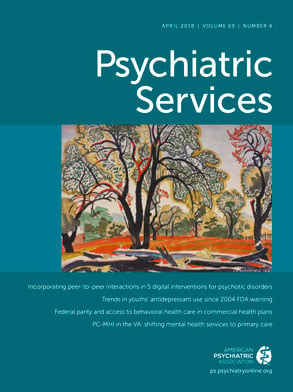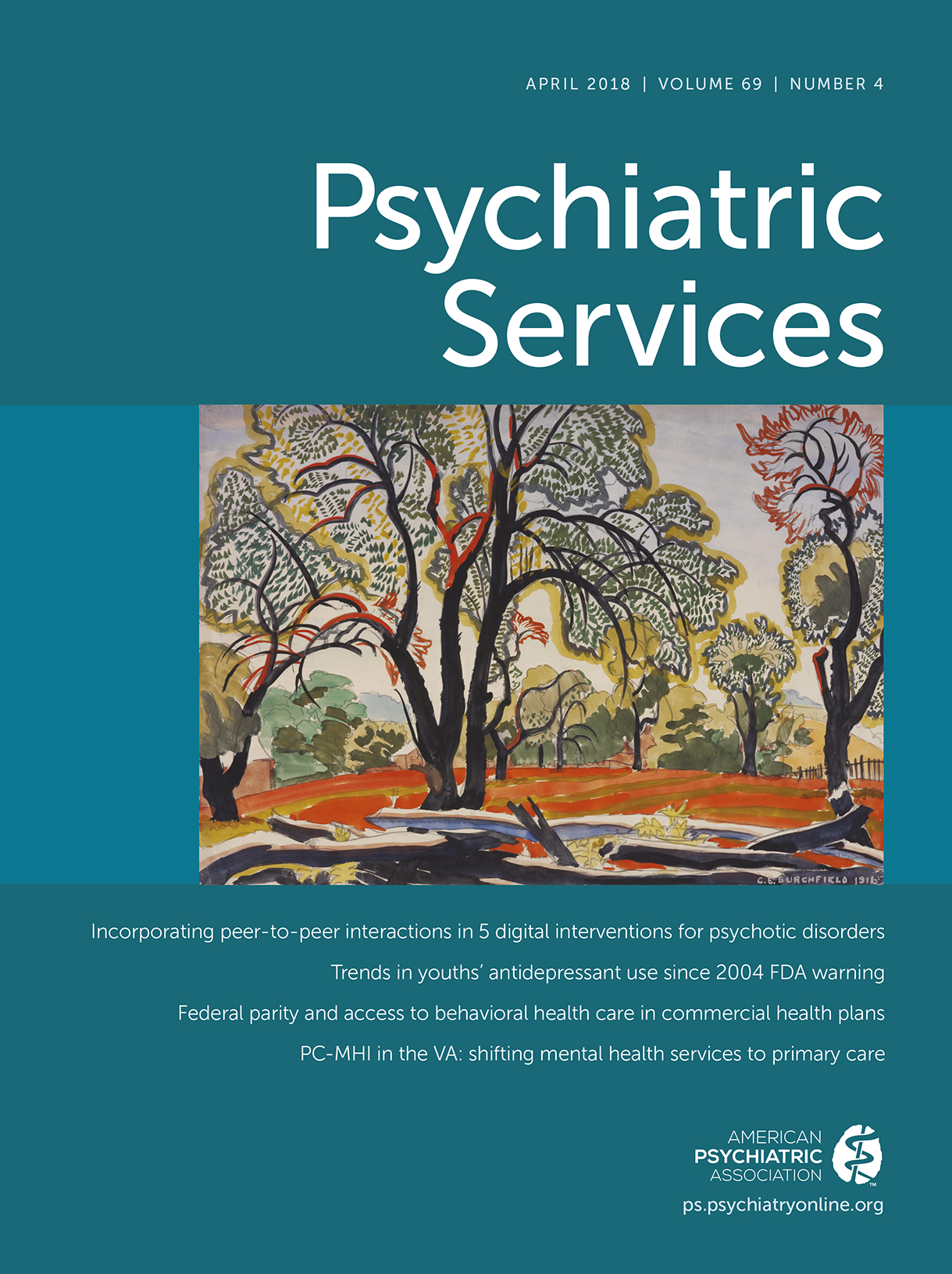Global efforts to end AIDS as a public health threat are under way (
1). However, the extent to which public psychiatric care systems are participating is unknown. Individuals with mental illness have higher rates of HIV infection and sexual risk behaviors than the general population, even among those with good HIV knowledge (
2).
Steps for ending AIDS include routine testing for HIV infection, prevention of infection among those who test HIV negative, and treatment to the point of viral suppression to prevent forward transmission for those who test HIV positive (
1). Psychiatric clinics are opportune settings for services tailored to persons with mental illness; clinicians and program staff can provide support, encourage participation in HIV services, establish linkages between systems of care, address barriers, and allay concerns. A strong therapeutic alliance is associated with greater acceptance of HIV testing and may have similar effects on prevention and treatment uptake (
3). Barriers to providing these services include limited staff training and lack of funds for condoms. Patients report that clinicians neglect discussing their sexual needs, desires for developing romantic partnerships, and complaints about the sexual side effects of medications—all of which may affect HIV risk (
2). Providers of general medical care are more likely than mental health care providers to report delivering HIV-related services (
4).
The Brazilian government, a leader in responding to the AIDS epidemic, funded HIV educational training in the public psychiatric care system (
5). This is the first report of outcomes of HIV risk reduction services provided in real-world public mental health programs. We examined client-level characteristics associated with having received treatment-as-usual HIV risk reduction programming among people attending public psychiatric clinics in Rio de Janeiro and the effects of program participation on HIV-related behaviors.
Methods
Adults self-referred or were referred by clinic providers at eight public mental health outpatient psychiatric clinics between June 2007 and November 2009 as part of a study funded by the National Institute of Mental Health and approved by U.S. and Brazilian institutional review boards. A research team psychiatrist and a clinic provider evaluated patients’ capacity to consent to study participation.
Formative work preceded tailoring instruments to enhance cultural specificity (
6,
7). Psychiatric diagnoses were determined by using the Mini International Neuropsychiatric Interview–PLUS, developed and validated for
DSM-IV and
ICD-10 diagnoses with both U.S. and Brazilian patients (
8). Sexual risk behaviors in the past three months were assessed with the Brazil Sexual Risk Behavior Assessment Schedule, a semistructured interview adapted to the local population with reasonable to excellent test-retest reliability (
9) that assesses sexual practices, number and type of partners, condom use, whether sex was exchanged for something (for example, money, drugs, or shelter), and alcohol and other drug use during sex. Sexual risk protective behaviors assessed for the past three months included reducing the number of sex occasions, decreasing the number of sex partners, changing risky sexual practices, and using condoms more frequently. HIV transmission and prevention knowledge was assessed with the Brazilian adaptation of the Brief HIV Knowledge Questionnaire (
9). Participants were asked whether they had undergone HIV testing in the past three months and whether within the past year they had participated in any type of program specifically intended to help them decrease sexual risks or increase safer sex.
Descriptive statistics included range, mean, and SD for continuous variables and count and percentage for nominal variables. Student’s t test was used for continuous dependent variables, and cross-tabulation and chi-square statistics were used for nominal variables to compare participants with and without prior exposure to risk reduction programs. Adjusted standardized residuals were computed to identify cells of the cross-tabulation in which there were significantly more participants than expected (positive adjusted standardized residual of ≥2) or fewer participants than expected (negative adjusted standardized residual of ≤2). For the 2 × 2 cross-tabulation, the chi-square statistic with continuity correction was used. Comparisons with p values ≤.05 were considered statistically significant.
Results
We recruited 641 outpatients who met eligibility criteria (that is, having vaginal or anal sex in the past three months, ages 18–80, not acutely suicidal or psychotic, and primary diagnosis other than an alcohol or other drug use disorder or developmental disability). Among the 641 outpatients, 211 (33%) had schizophrenia, 139 (22%) had bipolar disorder, 130 (20%) had nonpsychotic depression, 66 (10%) had depression with psychosis, 40 (6%) had anxiety disorders, 31 (5%) had psychosis not otherwise specified, 20 (3%) had schizoaffective disorder, four (1%) had other diagnoses, and nine (1%) had a secondary substance use disorder.
Table 1 presents data on demographic characteristics and associations with past-year participation in a sexual risk reduction program.
Race (self-identified as black or multiracial), HIV knowledge (higher scores), and HIV testing in the past three months were significantly associated with participation in a risk reduction program. No significant associations were found for sexual risk or protective behaviors or other variables.
Discussion
In this first study of the effects of participation in treatment-as-usual sexual risk reduction programs by sexually active persons attending public outpatient psychiatric clinics, only 9% reported participating in a sexual risk reduction program. This rate is dismaying given the considerable progress in understanding prevention, care, and treatment of HIV for this population. With Brazil’s comprehensive commitment to HIV prevention, including for those with mental illness, we expected much higher participation rates. Sexuality is considered a human right in Brazil, and mental health providers view helping patients to develop healthy intimate relationships as a desirable goal (
7). However, psychiatric settings in Brazil appear to have been as slow as settings elsewhere to address the HIV prevention needs of their sexually active patients (
7). This study demonstrates that treatment as usual is not sufficient, and mental health care systems need to scale up evidence-based programs and contribute to global efforts to stem new HIV infections.
Consistent with well-established theories (
10), participation in a risk reduction program was associated with greater HIV knowledge but not with safer behavior. One-quarter of patients reported consistent condom use in the prior three months, similar to patients in U.S. studies (
11), but this behavior was not linked to participation in risk reduction programs. Promoting condom use requires more rigorous dissemination of evidence-based interventions within the psychiatric care system.
Participating in sexual risk reduction programs was associated with recent HIV testing. Even so, in our study only 14% of participants in risk reduction programs reported HIV testing in the past three months. A Brazilian national multicenter study found that 27% of psychiatric patients reported ever being tested for HIV (
12). Both of these rates are low for a population at elevated risk of HIV infection. In our study, HIV testing identified two individuals in need of HIV treatment, and diagnosis of infection is the first step in the HIV continuum of care that is at the heart of initiatives to end AIDS.
In our study, 10% of all participants reported decreasing their number of sexual partners in the past three months to protect against HIV infection, 2% reported changing types of sexual behaviors, and 42% had used more condoms. None of these protective behaviors was associated with participation in sexual risk reduction programs. These results corroborate ample findings from the United States that call for implementing theory-driven, manualized, and efficacy-tested sexual risk reduction programs to promote safer sexual behavior.
Black and multiracial ethnicity was significantly associated with participation in sexual risk reduction programs; this finding is in contrast with findings in other countries, in which underinclusion of minority racial-ethnic groups in health care is a common disparity (
13). Almost half (47%) of this sample reported being married or in a long-term relationship. Future research should examine the extent to which HIV prevention is of salient concern in long-term partnerships and whether introducing condoms, a potentially difficult task, is warranted.
Relying on patient and provider referral for study participation and reliance on self-report are limitations of this study. Regarding the latter, we used validated instruments to counter response bias and improve recall (
14), except in the case of some protective behaviors, with documented test-retest reliability (
9). Those who participated in sexual risk reduction programs may have differed from those who did not in terms of access and reasons for participation. We obtained cross-sectional data; longitudinal studies are the next step. Caution is warranted in generalizing from the Brazil context, where health care is guaranteed, to countries where it is not and to adults with mental illness who are not inclined to participate in research; who are not in psychiatric treatment; or whose personal, clinical, socioeconomic, or cultural situations differ from those of the adults in this sample.
Conclusions
Almost three decades after the first descriptions of high rates of HIV infection among persons with mental illness, the epidemic remains highly overrepresented and poorly addressed in this population, even where resources have been dedicated. Individuals with mental illness are not routinely included in efforts to end AIDS. Recovery principles emphasize integrating general medical and mental health care for individuals with mental illness, but there has been limited uptake of HIV-focused health initiatives in mental health settings (
15). Mental health care systems must join efforts to end AIDS as a public health threat by delivering evidence-based HIV prevention services to reduce unsafe sexual behavior. This includes focusing on patient sexuality as a component of recovery-based services and introducing newer advances such as pre-exposure prophylaxis. Ending this epidemic will not be achieved as long as public health initiatives ignore public mental health care systems.
Acknowledgments
The authors gratefully acknowledge the enormous contributions made to the NIMH-sponsored Interdisciplinary Project on Sexuality, Mental Health, and AIDS (PRISSMA [PRojeto Interdisciplinar em Sexualidade, Saúde Mental e AIDS]) by individuals receiving care at the Instituto de Psiquiatria da Universidade Federal do Rio de Janeiro and the Instituto Philippe Pinel and by mental health care providers and other staff at these institutions. PRISSMA team members include Abmael de Sousa Alves, Erínia Belchior, Maria Tavares Cavalvanti, M.D., Ph.D., Denise Corrêa, Tatiana Dutra, Denise Feijó, M.D., Fernanda Gomes Luz, Alfredo Gonzalez, M.A., Carlos Linhares, Ph.D., Paulo Mattos, M.D., Ph.D., André Nunes, Cláudia Simone dos Santos Oliveira, Suely Olivera, M.A., Diana Pinto, Ph.D., Alexander Ramalho, Débora Salles, Marcia Silviano, and Vandré Matias Vidal.

